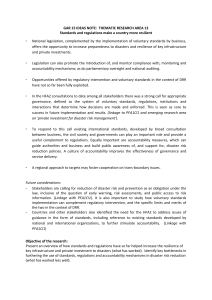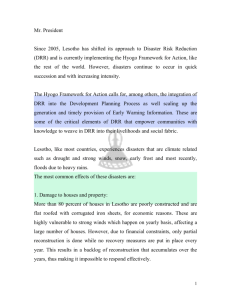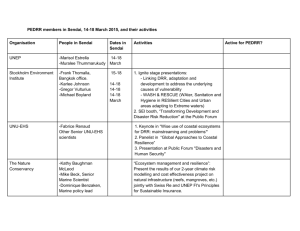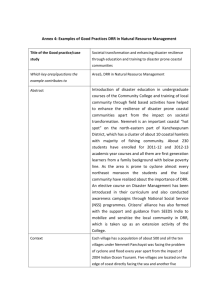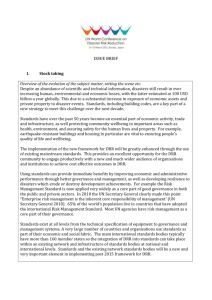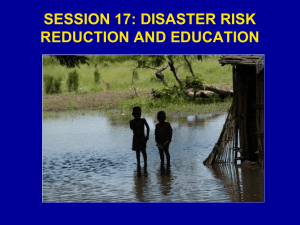Hungary - PreventionWeb
advertisement
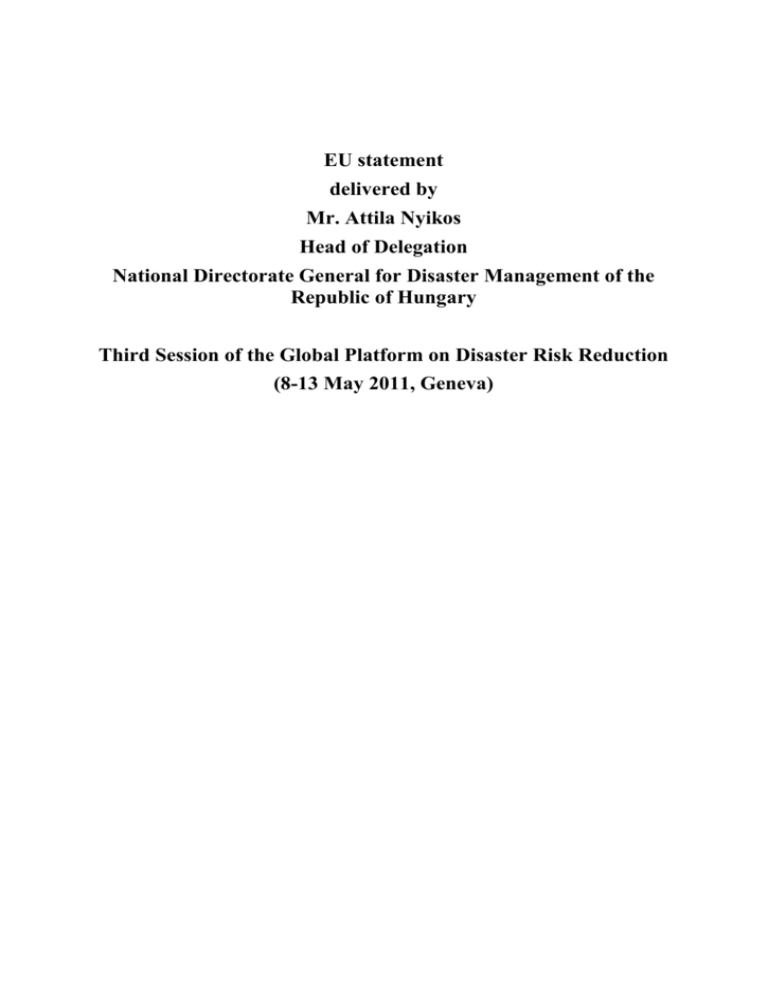
EU statement delivered by Mr. Attila Nyikos Head of Delegation National Directorate General for Disaster Management of the Republic of Hungary Third Session of the Global Platform on Disaster Risk Reduction (8-13 May 2011, Geneva) Ladies and gentlemen, The Republic of Hungary is currently holding the Presidency of the European Union and it is in this capacity, on behalf of the EU and its Member States that I would like to welcome and express strong support to the third session of the Global Platform for Disaster Risk Reduction. The recent years will be remembered as years in which the world experienced a series of particularly devastating natural disasters, entailing high loss of life. Here I would like to stop for a moment and remember all those who perished and suffered in the devastating earthquake and the subsequent tsunami in Japan. This unprecedented combination of geophysical and technological disasters underlines both the importance and complexity of Disaster Risk Reduction (DRR). Two other catastrophic disasters were the earthquake in Haiti and the floods in Pakistan in 2010. Europe and its immediate neighbours were also severely affected by natural disasters. The EU and its Member States respond rapidly to provide support to countries affected by disasters. As a consequence of global warming, population and poverty pressure the severity and impact of disasters are expected to increase in the future and thus undermine development and the achievement of the Millennium Development Goals. We therefore need to further strengthen our efforts to better prevent and to be better prepared for small and large scale disasters. The EU subscribed to the Hyogo Framework for Action right from the start in 2005. The steps that the EU and its Member States took both at the European level as well as in supporting developing countries with integrating disaster risk reduction in their national development strategies are fully in line with the Hyogo Framework for Action. The EU welcomes the mid-term review of the Hyogo Framework for Action. The findings and recommendations of the mid-term review report show that there is a need to accelerate the implementation of the HFA and clarify roles and responsibilities of various actors in bringing the DRR agenda forward. The EU also underlines the important role of the UN International Strategy for Disaster Risk Reduction in the field of advocacy, information management and coordination. The EU has developed and is implementing strategies on disaster risk reduction and prevention both inside and outside the EU. Our objective is to set up a consistent, effective, and comprehensive disaster risk reduction framework, including support to third countries on DRR. Apart from its clear linkage to humanitarian aid and relief, we also recognise the major role that building resilience and disaster risk reduction plays in contributing to sustainable development and achievement of the Millennium Development Goals. Therefore, we encourage clear and transparent risk-assessments and risk management cultures, both within and outside the EU. Developing fully fledged risk management policies will require the involvement of a wide range of actors at regional, national and local levels. The EU is also supporting initiatives and regional coordination efforts to reduce disasters and improve preparedness, including through the development of national disaster risk reduction platforms, involving all actors from the development, humanitarian, planning, environment, agriculture and civil protection side. The recent "Implementation Plan of the EU Strategy for Supporting Disaster Risk Reduction in developing countries" for the period 2011 – 2014 foresees the application of aid effectiveness principles in DRR, including increased coordination and cooperation between humanitarian and development actors within and outside the EU. We are committed to bring DRR and its linkage to climate change more strongly and systematically into development policies. Good DRR policy and practice can build resilience to the negative effects of climate change in the short to medium term by better managing climate risks. We want to make a difference by providing support in areas where the knowledge and expertise of the EU can be of added value (for example in risk assessment methodologies; in the development of early warning tools or in community based interventions) and build on the experience gained with actions implemented at the EU level such as the Community Civil Protection Mechanism and humanitarian assistance. This way we want to contribute to the overall efforts of our partners in developing countries, the affected communities themselves, as well as NGOs, international organisations and research communities to build more resilient societies. The EU and its Member States are committed to further improve internal coordination and to reinforce the linkages between DRR and climate change. We are encouraged by the strong link between climate adaptation and DRR expressed in the Cancun Agreements. Efforts will be made to improve the integration of DRR, climate adaption and mitigation into EU internal policies and in the EU’s development cooperation. We are committed to promote DRR at regional, national and local level in order to make sure that the relevant authorities and stakeholders have the necessary knowledge, expertise and technical tools at their disposal to integrate DRR into their strategies. However, mainstreaming is not enough; we also need to finance concrete actions and mobilise new donors to reduce the vulnerability of people, communities and poor countries to disasters. With this in mind, a number of targeted actions will: support areas such as information systems including early warning systems and risk and vulnerability mapping and analysis; support the implementation of national and regional strategies in view of reducing underlying risk factors; support risk sharing and insurance mechanisms; promote the inclusion of DRR elements in the recovery phase; and enhance practices at sub-national and local levels with special attention paid to vulnerable groups, gender issues and environmental sustainability. Let me stress this last point: the EU is strongly committed to build the resilience of vulnerable people where this is most apparent, at the local communities' level, where there is a compelling case for greater humanitarian-development interaction as well: recovery and linking relief, rehabilitation and development (LRRD) should become a joint policy objective. Post Disaster Needs Assessments are an important instrument in this respect. We all know that investing in DRR activities before a disaster happens pays significant dividends compared to paying for relief, recovery, and reconstruction after a disaster has occurred. However, we need to build the evidence base to show that DRR not only saves lives but also saves money. Cost benefit analyses show that building resilience, such as having early warning systems in place and training communities to act first, is more cost effective than a full-scale response. We are also confronted with a serious gap between actual and desirable financial means and the strong competition for funding between the different humanitarian and development priorities. Under these circumstances, ensuring cost-effective and improved investment in disaster risk reduction is a big challenge. We need to increase the impact of international, national and local resources for DRR, also looking at the various innovative financing instrument ideas. Furthermore, we need to give policymakers, businesses, and the general public tangible incentives to invest in prevention. Effective investment in DRR will help save lives, limit damage, and ultimately save money. We have now taken the first steps and 2011 should be a time for concrete delivery. This Global Platform is an essential milestone in this process. Ladies and gentlemen, Let me conclude by reiterating the strong commitment of the EU to supporting the implementation of the Hyogo Framework for Action and relevant DRR initiatives to build a world where human suffering and economic losses are reduced by increasing capacities to prevent, mitigate, prepare and respond to the consequences of natural and man-made disasters. ___________



